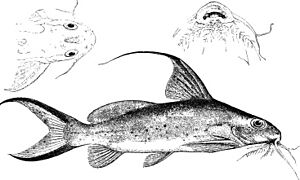Synodontis filamentosus facts for kids
The longfin synodontis (Synodontis filamentosus) is a cool type of upside-down catfish. It lives in the big rivers of Africa, like the Nile, Volta, and Niger River, and also in the Chad Basin. A British-Belgian scientist named George Albert Boulenger first described this fish in 1901. He found it near Lake No in Sudan. Its name filamentosus comes from the long, thread-like parts on its back and tail fins.
Quick facts for kids Synodontis filamentosus |
|
|---|---|
 |
|
| Conservation status | |
| Scientific classification | |
| Genus: |
Synodontis
|
| Species: |
filamentosus
|
What Does the Longfin Synodontis Look Like?
Like other Synodontis fish, the longfin synodontis has a strong, bony head. This bony part goes all the way back to its first back fin spine. Its head also has a special bony bump called a humeral process. This bump helps scientists tell different Synodontis species apart. For the longfin synodontis, this bump is flat and a bit longer than it is wide. It has a rounded end.
This fish has three pairs of barbels, which are like whiskers. One pair is on its upper jaw, and two pairs are on its lower jaw. The upper jaw barbels are straight and have a wide base. They are about three-quarters the length of the fish's head. The outer pair of lower jaw barbels is about one and a half times longer than the inner pair. These outer barbels have long, thin branches, and even smaller branches coming off them.
The front edges of the back fin and the side fins of Synodontis fish are hard, stiff spines. In the longfin synodontis, the back fin spine is as long as its head. It curves a bit and is smooth on the front but rough on the back. The rest of the back fin has seven soft rays. These rays end in a long, thin filament that is even longer than the fin itself! The side fin spine is as long as the back fin spine and is rough on both sides.
The small, fleshy fin near its tail, called the adipose fin, is about four and a half times longer than it is deep. The fin on its belly, called the anal fin, has four unbranched rays and seven branched rays. It has a rounded shape. The tail fin is deeply split, like a swallow's tail, with the top part being longer.
All Synodontis fish have a special pad of teeth on the very front of their upper jaw. This pad has rows of short, chisel-shaped teeth. In the longfin synodontis, this tooth pad is short and wide. On its lower jaw, the teeth are attached to flexible, stalk-like parts. They are shaped like an "s" or a hook. The number of teeth on the lower jaw helps identify the species. The longfin synodontis has about 20 teeth on its lower jaw.
The longfin synodontis is usually greyish with small, dark spots spread out. Its underside is whitish. The back fin and tail fin have small greyish spots. The bottom edges of its tail fin are black. This fish can grow up to about 26 centimeters (10 inches) long. Female Synodontis fish are usually a bit bigger than males of the same age.
Where Does it Live and What Does it Do?
In the wild, the longfin synodontis lives across central Africa. You can find it from Guinea all the way to Ethiopia. People in these areas catch this fish for food.
Scientists don't know much about how most Synodontis species reproduce. They have found eggs in some female fish, which tells them a little. It's likely that these fish lay their eggs during the rainy season, which is usually between July and October. During this time, pairs of fish might swim together to lay eggs. Young fish grow very quickly in their first year. After that, their growth slows down as they get older.


